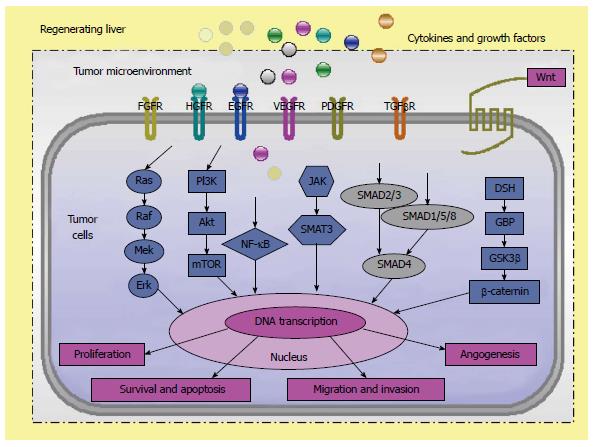Copyright
©2014 Baishideng Publishing Group Inc.
World J Gastroenterol. Nov 21, 2014; 20(43): 16167-16177
Published online Nov 21, 2014. doi: 10.3748/wjg.v20.i43.16167
Published online Nov 21, 2014. doi: 10.3748/wjg.v20.i43.16167
Figure 1 Molecule-mediated liver regeneration through interactions between mature hepatocytes and non-parenchymal liver cells: Kupffer cells, sinusoidal endothelial cells, biliary endothelial cells, stellate cells (adapted from Paschos and Bird[19]).
EGF: Epidermal growth factor; FGF: Fibroblast growth factor; HGF: Hepatocyte growth factor; IL-6: Interleukin 6; MMPs: Matrix metallopeptidases; PDGF: Platelet-derived growth factor; TNF: Tumour necrosis factor; TGF-α: Transforming growth factor α; TGF-β1: Transforming growth factor β1; VEGF: Vascular endothelial growth factor.
Figure 2 Molecule-mediated signal pathways in the propagation of liver cancer during liver regeneration.
NF-κB and JAK/STAT3 pathways, Phosphatidylinositol-3 kinase (PI3K)/AKT pathway, Ras/Raf/Mek/Erk pathway, TGF-β/SMAD pathway, WNT/β-catenin pathway and activation of nuclear transcription are implicated in this process. EGFR: Epidermal growth factor/transforming growth factor α receptor; FGFR: Fibroblast growth factor receptor; HGFR: Hepatocyte growth factor receptor; PDGFR: Platelet-derived growth factor receptor; TGFβ: Transforming growth factor beta receptor; VEGFR: Vascular endothelial growth factor receptor.
- Citation: Shi JH, Line PD. Effect of liver regeneration on malignant hepatic tumors. World J Gastroenterol 2014; 20(43): 16167-16177
- URL: https://www.wjgnet.com/1007-9327/full/v20/i43/16167.htm
- DOI: https://dx.doi.org/10.3748/wjg.v20.i43.16167










